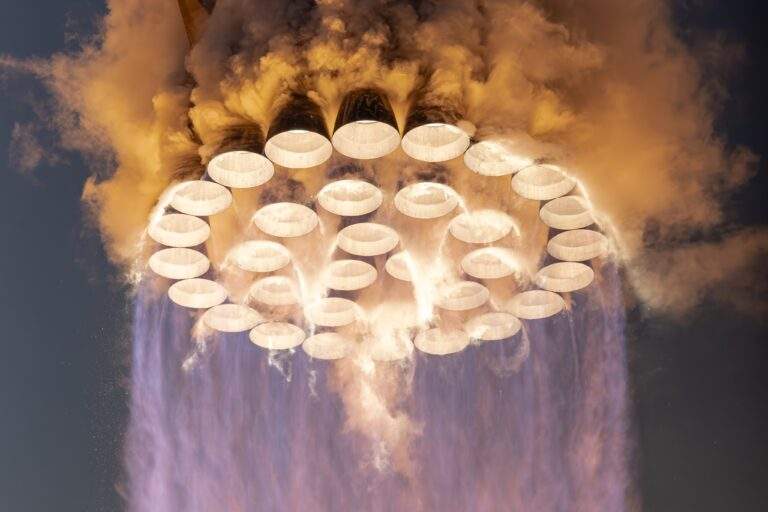In February 2018, SpaceX launched the Falcon Heavy rocket for the first time. This was an incredible launch which showed the world exactly what SpaceX was capable of. But just a few weeks later, another SpaceX launch took off with much less publicity. This was the launch of satellites Tintin A and B, SpaceX’s very first Starlink satellites. Since then, Starlink launches have become routine and they are now the biggest part of SpaceX’s launch scheduele.
With plans to create an enormous constellation of internet satellites, SpaceX started producing and launching Starlink satellites at a ridiculous rate. By the end of 2020, they already had around 1,000 starlink satellites in orbit. To put this into perspective, at the time, there were only around 3,000 total satellites in orbit. But this incredible launch cadence didn’t last forever.

SpaceX stops launching
After launching satellites on an almost weekly basis at the start of 2021, SpaceX suddenly went silent after June. We’re going to look at why SpaceX decided to put their Starlink launches on hold. We’re also going to look at why their commercial satellite launches decreased and what the future of SpaceX’s launch schedule might look like.
Before Starlink came around, SpaceX made most of its revenue from launching other people’s satellites and sending cargo to the international space station. They quickly managed to corner a large portion of the satellite market due to their incredibly low launch prices. Since the Falcon 9 is mostly reusable, SpaceX saves so much money per launch compared to other rockets that have to be completely rebuilt for each mission. When they started launching Starlink, it gave the Falcon 9 much more work to do. But since SpaceX was its own customer, it was losing an enormous amount of money on these launches.
Now that Starlink is operational, SpaceX is pulling in some revenue. But since its coverage is still relatively small, Starlink is far from being profitable. The cost to manufacture each Starlink user kit alone is around double the price that they sell them for. So Starlink still has many improvements to make before it’s successful. One of the most crucial parts of the Starlink constellation is having satellites that are able to communicate with each other.
Initially, Starlink satellites could only communicate with ground stations. Meaning that data traveling extremely far distances around the globe had to take a much longer and slower path. In order to send data quickly around the Earth, it makes more sense to send the data from one satellite to another.

Starlink laser links
And so, SpaceX designed Starlink to eventually have lasers that can beam enormous amounts of data to nearby satellites, creating a chain of data that could reach any part of the globe. The reason this is so game changing is because the speed of light in space is considerably faster than the fiber optic cables beneath the sea, where most of our internet travels. The other benefit is that Starlink satellites are much lower than traditional geostationary satellites. This means that the signal has to travel a much shorter route to reach the satellite and travel back down to Earth.
Nevertheless, these new and improved laser satellites weren’t quite ready. But SpaceX didn’t want to keep producing and launching the old satellites, which would soon be obsolete. SpaceX manufactures all of its Starlink satellites in a factory in Washington, where around 120 satellites can be made each month. But at the start of summer, SpaceX most likely shut down its production line and redesigned the manufacturing process to support the new and improved satellites.
The final dedicated Starlink launch lifted off in May with an extra 3 Starlink sats being launched during a rideshare mission in June. SpaceX then went almost 2 entire months without launching a single rocket. But it’s not just Starlink launches that took a hit in 2021.
It’s not just Starlink’s fault
In general, SpaceX’s commercial satellite business has seen a decrease in launches since 2018. This is largely down to the satellite industry as a whole. In recent years, satellites have gone from being enormous and bulky to being much smaller and capable machines. If you’ve got a small satellite, it’s not worth buying an entire Falcon 9 launch if you will only use a fraction of the space and payload capacity.
So, small satellites typically launch on smaller rockets like Rocketlab’s Electron – or they group together with many other satellites and share the ride into space. SpaceX started doing a rideshare program like this, and it has gone on to be extremely succesful. With each rideshare mission, companies can launch their payloads for as little as $5,000 per kg.

SpaceX resume launching
But it wasn’t until mid September that Starlink launches resumed – this time with the new and improved laser satellites. But as SpaceX continues to develop Starlink, the future of their launches will look very different. In the near future, SpaceX will start launching Starlink version 2. These will be larger satellites, so in order to launch many at the same time, it’s crucial that SpaceX has Starship up and running, or else Starlink could fail to become profitable.
Right now, the success of Starlink and Starship is far from guaranteed, only time will tell. Either way, it’s incredible to see these amazing projects come together right in front of our eyes. In order for this amazing future to become a reality, SpaceX has to build a team of the world’s best engineers and technicians.












